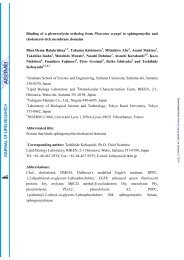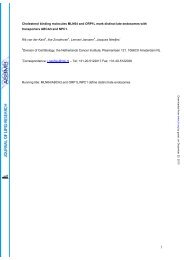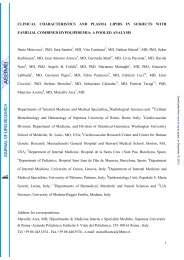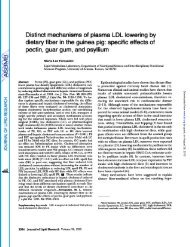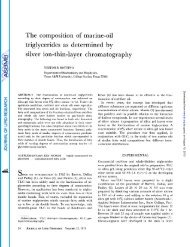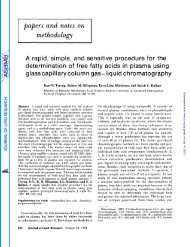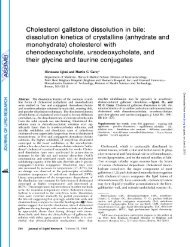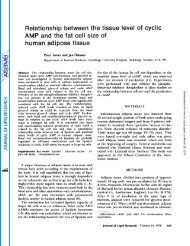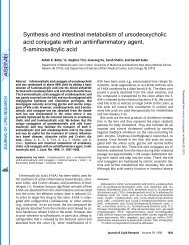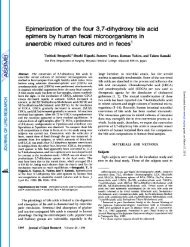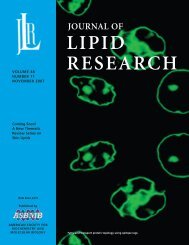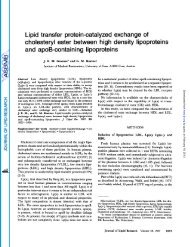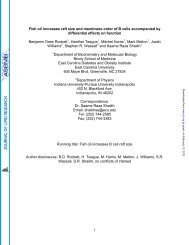Meshulam et al JLR revised - The Journal of Lipid Research
Meshulam et al JLR revised - The Journal of Lipid Research
Meshulam et al JLR revised - The Journal of Lipid Research
Create successful ePaper yourself
Turn your PDF publications into a flip-book with our unique Google optimized e-Paper software.
Caveolins/Caveolae Protect Adipocytes From Fatty Acid-Mediated<br />
Lipotoxicity<br />
Tova <strong>Meshulam</strong> 1 , Michael R. Breen 1 , Libin Liu 1,3 , Robert G. Parton 4,5 and Paul F. Pilch 1, 2 *<br />
1 Departments <strong>of</strong> Biochemistry and Medicine 2 , Boston University School <strong>of</strong> Medicine, 715<br />
Albany St., Boston, MA 02118 4 <strong>The</strong> University <strong>of</strong> Queensland, Institute for Molecular<br />
Bioscience and 5 Centre for Microscopy and Microan<strong>al</strong>ysis, Brisbane, Queensland 4072,<br />
Austr<strong>al</strong>ia.<br />
3 Current Address, Joslin Diab<strong>et</strong>es Center, One Joslin Place, Boston, MA 02215<br />
*Corresponding Author<br />
Department <strong>of</strong> Biochemistry<br />
Boston University School <strong>of</strong> Medicine,<br />
715 Albany St.<br />
Boston, MA 02118<br />
Tel. 617-638-4044<br />
Fax 617-638-4208<br />
Email ppilch@bu.edu<br />
Running title: Caveolae and lipotoxicity<br />
Abbreviations: ATGL, adipocyte triglyceride lipase; Cav1, caveolin-1; Cav2, caveolin-2;<br />
dbcAMP, O-dibutyryladenosine-3’5’-cyclic monophosphate; FA, fatty acid; HSL, hormone<br />
sensitive lipase; Iso, Isoproterenol; LDH, lactic dehydrogenase; MEF, mouse embryonic<br />
fibroblast; PKA protein kinase A.<br />
1<br />
Downloaded from<br />
www.jlr.org<br />
by guest, on April 9, 2013
ABSTRACT<br />
Mice and humans lacking function<strong>al</strong> caveolae are dyslipidemic and have reduced fat stores and<br />
sm<strong>al</strong>ler fat cells. To test the role <strong>of</strong> caveolins/caveolae in maintaining lipid stores and adipocyte<br />
integrity, we compared lipolysis in caveolin-1 null fat cells to that in cells reconstituted for<br />
caveolae by caveolin-1 re-expression. We find that the Cav1 null cells have a modestly enhanced<br />
rate <strong>of</strong> lipolysis and reduced cellular integrity compared to reconstituted cells as d<strong>et</strong>ermined by<br />
the release <strong>of</strong> lipid m<strong>et</strong>abolites and lactic dehydrogenase, respectively, into the media. <strong>The</strong>re are<br />
no apparent differences in the levels <strong>of</strong> lipolytic enzymes or hormon<strong>al</strong>ly stimulated<br />
phosphorylation events in the two cell lines. In addition, acute fasting, which dramatic<strong>al</strong>ly raises<br />
circulating fatty acid levels in vivo, causes a significant up-regulation <strong>of</strong> caveolar protein<br />
constituents. <strong>The</strong>se results are consistent with the hypothesis that caveolae protect fat cells from<br />
the lipotoxic effects <strong>of</strong> elevated levels fatty acids, which are weak d<strong>et</strong>ergents at physiologic<strong>al</strong><br />
pH, by virtue <strong>of</strong> the property <strong>of</strong> caveolae to form d<strong>et</strong>ergent resistant membrane domains.<br />
Key words: Caveolin-1, Cavin, Fasting, <strong>Lipid</strong> rafts, Lipolysis<br />
2<br />
Downloaded from<br />
www.jlr.org<br />
by guest, on April 9, 2013
INTRODUCTION<br />
Proper functioning <strong>of</strong> adipocytes with regard to fatty acid (FA) storage and release is an<br />
essenti<strong>al</strong> aspect <strong>of</strong> fuel homeostasis, and dysregulation <strong>of</strong> these processes can lead to obesity and<br />
type 2 diab<strong>et</strong>es mellitus (1). Along with their characteristic<strong>al</strong>ly large lipid dropl<strong>et</strong>s, striking<br />
features <strong>of</strong> fat cells are cell surface structures c<strong>al</strong>led caveolae or little caves, sm<strong>al</strong>l (50-100 nM)<br />
invaginations <strong>of</strong> the plasma membrane into the cytosol (2) that are especi<strong>al</strong>ly abundant in this<br />
cell type, constituting as much as 50% <strong>of</strong> the surface area (3). In non-muscle cells, caveolae are<br />
formed due to the expression <strong>of</strong> caveolins-1 and -2 (Cav1 and Cav2) (4), cavin-1 (5-7) and<br />
probably cavin-2 (8). <strong>The</strong> caveolins are sm<strong>al</strong>l integr<strong>al</strong> membrane proteins (4) and the cavins are<br />
peripher<strong>al</strong> membrane proteins without enzymatic activity that are tightly associated with<br />
caveolae (2,9). Mice lacking caveolin-1 generated by gene knockout technology are lean, have<br />
abnorm<strong>al</strong>ly sm<strong>al</strong>l fat cells and are insulin resistant (10), a phenotype mirrored in humans with<br />
inactivating Cav1 mutations (11,12). Moreover, mice (6) and humans (13-16) lacking function<strong>al</strong><br />
cavin-1 are <strong>al</strong>so lean, lipodystrophic and insulin resistant, amongst other pathologies they harbor.<br />
<strong>The</strong>se facts suggest that caveolae serve one or more functions specific to adipocytes and their<br />
lipid m<strong>et</strong>abolism.<br />
Caveolae are a subs<strong>et</strong> <strong>of</strong> so-c<strong>al</strong>led membrane lipid raft domains that are <strong>of</strong>ten<br />
experiment<strong>al</strong>ly defined by their resistance to solubilization by brief exposure to non-ionic<br />
d<strong>et</strong>ergents (17). Fatty acid (FA) anions are <strong>al</strong>so weak d<strong>et</strong>ergents at physiologic<strong>al</strong> pH and are<br />
trafficked in abundant amounts in and out <strong>of</strong> fat cells. Consequently we and others have<br />
suggested that caveolae could serve to protect adipocytes (and other cells) from the possible<br />
toxic effects <strong>of</strong> FA by serving as a membrane “buffer” for these molecules (18-20). Indeed, we<br />
showed that HEK293 cells over expressing caveolin-1 or caveolin-3 were resistant to the toxic<br />
3<br />
Downloaded from<br />
www.jlr.org<br />
by guest, on April 9, 2013
effects <strong>of</strong> prolonged incubation with physiologic<strong>al</strong>ly high levels <strong>of</strong> FA (20). However, as<br />
compared to adipocytes these cells lack the capacity to store large amounts <strong>of</strong> triglycerides, and<br />
they <strong>al</strong>so lack the hormone sensitive lipolytic protein machinery <strong>of</strong> the fat cell (21). Thus, while<br />
the HEK293 cell line serves as a useful model system for a vari<strong>et</strong>y <strong>of</strong> purposes, it does not reflect<br />
the robust FA trafficking and lipid m<strong>et</strong>abolism <strong>of</strong> the adipocyte, the physiologic<strong>al</strong>ly relevant cell<br />
in this regard. Consequently, we took advantage <strong>of</strong> the caveolin-1 null mouse (5) to create an<br />
adipocyte cell line from their embryonic fibroblasts, and “rescued” these cells by expressing<br />
caveolin-1 in order to compare lipolysis and its effects in this context. Indeed, we show that<br />
caveolae do in fact protect fat cells from the autolysis that results from lipolytic stimulation by<br />
sever<strong>al</strong> agents including adrenergic hormones.<br />
4<br />
Downloaded from<br />
www.jlr.org<br />
by guest, on April 9, 2013
EXPERIMENTAL PROCEDURES<br />
Antibodies: A polyclon<strong>al</strong> antibody against caveolin-1 and monoclon<strong>al</strong> anti-caveolin 2 were<br />
purchased from BD transduction Laboratories (San Jose, CA), anti-actin was from Sigma (St.<br />
Louis, Mo.). Monoclon<strong>al</strong> anti-caveolin-1 antibodies were produced in our laboratory (22). Anti-<br />
peptide antibodies directed against cavin-1, -2 and -3 (7,8) were made by 21 st Century<br />
Biochemic<strong>al</strong>s, Marlboro, MA. Polyclon<strong>al</strong> antibodies against perilipin, hormone sensitive lipase<br />
(HSL) and adipocyte triglyceride lipase (ATGL) were kindly provided by Dr. Andrew Greenberg<br />
(Tufts University, Boston, MA). Polyclon<strong>al</strong> anti-aP2 was kindly provided by Dr. David Bernlohr<br />
(University <strong>of</strong> Minnesota). Anti-phospho-PKA substrate antibody was kindly provided by Dr.<br />
M.S. Gauthier (Boston University Medic<strong>al</strong> School) (23).<br />
Reagents: Dexam<strong>et</strong>hasone, 3-isobutyl-1-m<strong>et</strong>hylxanthine, and insulin were purchased from<br />
Sigma (St. Louis, MO). Triglyceride-GPO Reagent S<strong>et</strong> was purchased from Pointe Scientific Inc.<br />
(Canton MI). Isoproterenol, the adenylate cyclase activator, forskolin and O-dibutyryladenosine-<br />
3’5’-cyclic monophosphate (dbcAMP) were obtained from Sigma, and the FuGENE 6<br />
transfection reagent was purchased from Roche Diagnostics (Indianapolis, IN).<br />
Cell culture: Primary Mouse Embryonic fibroblast (MEFs) obtained from wild type and Cav1-<br />
null mice (5). Cells were grown in Dulbecco's modified Eagle's medium (DMEM) from<br />
Mediatech Inc., (Herndon, VA), containing a mixture <strong>of</strong> penicillin (50 units/mL) and<br />
streptomycin (50 µg/mL) from Invitrogen. <strong>The</strong> medium was supplemented with 10% f<strong>et</strong><strong>al</strong><br />
bovine serum (FBS) (Invitrogen). Cells were immort<strong>al</strong>ized using a 3T3 cell passaging protocol<br />
(24). Cells were passaged continuously every 3 days and plated at 6 x 10 5 cells/100mm dish until<br />
the growth rate become relatively rapid and cells had a fibroblastic morphology (~passage 20<br />
and beyond). Confluent cells were induced to differentiate using a cocktail <strong>of</strong> insulin (1.7µM),<br />
5<br />
Downloaded from<br />
www.jlr.org<br />
by guest, on April 9, 2013
isobutylm<strong>et</strong>hylxanthine (0.5 mM), dexam<strong>et</strong>hasone (1 µM) (25) and troglitazone (5µM) (26).<br />
After 2-3 days, cells were maintained in FBS containing 10% FBS and 0.85 µM insulin and<br />
troglitazone (5 µM) for 3 days, then in medium containing 10% FBS and troglitazone for a tot<strong>al</strong><br />
<strong>of</strong> 8-10 days.<br />
Anim<strong>al</strong>s: M<strong>al</strong>e Sprague Dawley rats (175 gm) were obtained from Charles River Labs<br />
(Wilmington, MA) and fed ad libitum or fasted prior to isolation <strong>of</strong> primary (epididym<strong>al</strong>) fat<br />
cells and Western blot an<strong>al</strong>ysis as previously described (27) and approved by the Boston<br />
University Medic<strong>al</strong> Center Institution<strong>al</strong> Anim<strong>al</strong> Care and Use Committee.<br />
R<strong>et</strong>rovir<strong>al</strong> vectors: <strong>The</strong> cDNA encoding for mouse caveolin-1 was subcloned into BamHI and<br />
EcoRI sites <strong>of</strong> the pBABE-puro r<strong>et</strong>rovir<strong>al</strong> vector. Transfection was done as described before<br />
(28). HEK-293T cells were grown in Dulbecco's modified Eagle's medium (DMEM) as above<br />
but containing 10% F<strong>et</strong><strong>al</strong> Bovine serum (Invitrogen) to 70% confluence in 100-mm-diam<strong>et</strong>er<br />
dishes, at which stage they were transfected with a DNA-FuGENE cocktail consisting <strong>of</strong> 54 µl<br />
Fugene 6 transfection reagent, 6 µ g r<strong>et</strong>rovirus constructs, 6 µ g pVPack-VSV-G vector, 6 µg<br />
pVPack-GAG-POL vector, and DMEM without FBS to fin<strong>al</strong> volume <strong>of</strong> 200 µ l. As a control,<br />
cells were transfected with pBabe-puro empty vector. Twenty-four hours later, the medium was<br />
replaced with 6 ml fresh DMEM containing 10% FBS. After an addition<strong>al</strong> 24 hours, the<br />
supernatant containing high-titer r<strong>et</strong>rovirus was collected and filtered through a 0.45-µm-pore-<br />
size filter. <strong>The</strong> vir<strong>al</strong> filtrates were added to the targ<strong>et</strong> cells. After infection, cells were selected for<br />
5 days in compl<strong>et</strong>e medium containing puromycin at a fin<strong>al</strong> concentration <strong>of</strong> 2.5 µg/ml.<br />
Following selection cells were maintained in medium containing 1.25 µg/ml puromycin. Stable<br />
expression in the targ<strong>et</strong> cell population was confirmed by Western blot an<strong>al</strong>ysis.<br />
6<br />
Downloaded from<br />
www.jlr.org<br />
by guest, on April 9, 2013
Preparation <strong>of</strong> Whole Cell Extracts: Cells were washed 3 times with PBS and incubated for 30<br />
minutes on ice with iced-cold RIPA buffer containing 50 mM Tris, pH 7.5; 150 mM NaCl; 1%<br />
Nonid<strong>et</strong> P-40, 0.5% sodium deoxycholate and 0.1% SDS and a protease inhibitor cocktail<br />
(Aprotinin 10µg/ml, Pepstatin 1 µg/ml and Leupeptin 5 µg/ml from American Bioan<strong>al</strong>ytic<strong>al</strong>).<br />
Lysates were vortexed and spun down for 20 min. at 16,000 g at 4 o C. Protein concentrations<br />
were d<strong>et</strong>ermined in the supernatant using the bicinchoninic acid (BCA) reagent (Pierce,<br />
Rockford, IL).<br />
Gel Electrophoresis and Immunoblotting: Proteins were separated by SDS-PAGE (acrylamide<br />
from Nation<strong>al</strong> Diagnostics) and electrophor<strong>et</strong>ic<strong>al</strong>ly transferred to polyvinylidene difluoride<br />
membrane (Bio-Rad, Hercules, CA). <strong>The</strong> membrane was then blocked with 10% nonfat dry milk<br />
in PBS containing 0.5% Tween-20 for 1 hour at room temperature. Primary antibodies were<br />
d<strong>et</strong>ected using secondary antibodies conjugated to horseradish peroxidase from Sigma and<br />
chemiluminescence substrate from PerkinElmer Life Sciences (Boston, MA).<br />
Lipolysis: Cells were grown to confluence in 6-well plates and induced to differentiate as<br />
described above. On the day <strong>of</strong> the experiment, adipocytes were preincubated for 4 hours in<br />
serum-free DMEM containing 0.5% fatty acid free BSA (American Bioan<strong>al</strong>ytic<strong>al</strong>). Cells were<br />
washed three times with warm DMEM and then treated with 10 µM β-adrenergic agonist<br />
isoproterenol, 20 µM adenylate cyclase activator forskolin or 1 mM dbcAMP. Agonists were<br />
prepared in serum free culture medium containing 0.5% fatty acid free BSA and 1ml was added<br />
to each well. Aliquots were removed at 1, 2, and 4 h <strong>of</strong> stimulation and the glycerol content <strong>of</strong><br />
each <strong>of</strong> these samples was measured using the Triglyceride (GPO) Reagent S<strong>et</strong> and measured at<br />
540 nm against a s<strong>et</strong> <strong>of</strong> glycerol standards as in previous studies (20). Cells were then washed<br />
with cold PBS, lysed with a RIPA buffer, and the protein concentration was d<strong>et</strong>ermined and used<br />
7<br />
Downloaded from<br />
www.jlr.org<br />
by guest, on April 9, 2013
to norm<strong>al</strong>ize glycerol release. Unesterified fatty acids from cells treated as above were measured<br />
in DMEM media without phenol red and the glucose concentration was adjusted to 4.5 g/l using<br />
a kit from Waco Diagnostics (Richmond, VA). <strong>The</strong> 4hour time-point samples were used for<br />
measuring LDH release using QuantiChromTM Lactate Dehydrogenase Kit (DLDH-100)<br />
Biosystems (Hayward, CA) as per manufacturer’s recommendations.<br />
Confoc<strong>al</strong> Laser Scanning Microscopy: Cells were grown in 6 well plates to confluence and<br />
were induced to differentiate. On day 8 <strong>of</strong> differentiation, cells were washed three times with<br />
PBS, trypsinized, and plated again into 6 well plates containing coverslips pr<strong>et</strong>reated with 0.1%<br />
gelatin (Millipore Billerica, MA). After 24 hours cells were fixed with 3.7% form<strong>al</strong>dehyde in<br />
PBS for 20 min at room temperature. Cells were permeabilized with solution A (0.1% saponin<br />
and 0.4% BSA in PBS) for 10 min and then blocked for 1 h at room temperature in 5% norm<strong>al</strong><br />
goat serum (Sigma) in PBS. Staining was performed with rabbit polyclon<strong>al</strong> anti-caveolin-1<br />
antibody overnight at a dilution <strong>of</strong> 1/100 in 1% norm<strong>al</strong> goat serum in PBS. Following staining<br />
cells were washed four times with buffer A. Cells were incubated with anti-rabbit Cy3-<br />
conjugated secondary antibody (Jackson Immuno<strong>Research</strong> Laboratories, Inc.) at a dilution <strong>of</strong><br />
1/200 in 1% norm<strong>al</strong> goat serum in PBS. <strong>The</strong> cells were covered in <strong>al</strong>uminum foil and incubated<br />
for 1 h at room temperature. <strong>The</strong> cells were washed again for 3 times with solution A and then<br />
mounted with Vectashield mounting medium with DAPI (Vector Laboratories, Inc. Burlingame,<br />
CA). <strong>The</strong> stained cells were observed using a Zeiss 510 confoc<strong>al</strong> laser-scanning microscope<br />
(Carl Zeiss, Thornwood, NY). Images were processed using LSM 510 Image s<strong>of</strong>tware.<br />
8<br />
Downloaded from<br />
www.jlr.org<br />
by guest, on April 9, 2013
RESULTS<br />
A permanent pre-adipocyte cell line was created from embryonic fibroblasts obtained<br />
from (Cav1) null mice (5) as described in the Experiment<strong>al</strong> Procedures section. <strong>The</strong>se cells were<br />
then infected with Cav1- or empty vector-expressing r<strong>et</strong>rovirus. As shown in Figure 1A, infected<br />
cells (Cav1+) express Cav1, which increases somewhat during differentiation, but not to the<br />
same extent as the endogenous protein in 3T3-L1 cells (29), and vector expressing cells (Cav1<br />
null) lack Cav-1 expression as expected. Caveolin-2 (Cav2) levels are greatly reduced in Cav1-<br />
null cultured adipocytes and are restored by Cav1 expression as would be expected from prior<br />
data showing Cav2 requires Cav1 expression for recruitment into caveolae (30). We <strong>al</strong>so<br />
characterized the Cav1 null and wild type cells prior to infection and these appear identic<strong>al</strong> in<br />
appearance and caveolar protein expression to the vector-transfected and rescued cells,<br />
respectively and have comparable levels <strong>of</strong> hormon<strong>al</strong>ly-stimulated lipolysis (data not shown).<br />
Interestingly, cavin-1 expression is the same in Cav1 null and rescued (+Cav1) cell lines. This<br />
protein is obligatory for caveolae formation (5-7) and <strong>al</strong>ong with cavins-2 & -3, is a member <strong>of</strong><br />
the cavin family <strong>of</strong> putative caveolar coat proteins in non-muscle cells (8). All three cavin<br />
is<strong>of</strong>orms are expressed in the cav1 null cell line (Figure 1A) <strong>al</strong>though cavin-2 expression is<br />
reduced in the absence <strong>of</strong> Cav1. <strong>The</strong> Cav1 null fat cells are larger and exhibit larger lipid<br />
dropl<strong>et</strong>s than cells harboring Cav1 (Figure 1B). <strong>The</strong> Cav1 reconstituted cells closely resemble<br />
3T3-L1 cells in their morphology and lipid dropl<strong>et</strong> size (not shown). Fin<strong>al</strong>ly, the Cav1 rescued<br />
cells targ<strong>et</strong> this protein to the plasma membrane as shown in Figure 1C by immun<strong>of</strong>luorescence.<br />
<strong>The</strong> dyslipidemia seen in mice lacking adipocyte caveolae is accompanied by reduced<br />
adiposity and higher levels <strong>of</strong> circulating FA and triglycerides (10,6), and consequently we<br />
assessed how the Cav1 null adipocytes in vitro respond to lipolytic stimuli by measuring FA and<br />
9<br />
Downloaded from<br />
www.jlr.org<br />
by guest, on April 9, 2013
glycerol release under bas<strong>al</strong> and stimulated conditions. As shown in Figure 2, after exposure to<br />
the lipolytic agents, forskolin and isoproterenol, the Cav1 null cells hydrolyze triglycerides to a<br />
slightly but significantly higher extent than the Cav1 expressing cells and they show equiv<strong>al</strong>ent<br />
bas<strong>al</strong> lipolysis.<br />
<strong>The</strong> differences in lipolysis could be explained by a number <strong>of</strong> factors including<br />
differences in lipolytic enzyme expression and/or lipolytic sign<strong>al</strong>ing. Accordingly, we measured<br />
expression levels for a number <strong>of</strong> proteins involved in adipocyte FA lipolysis in Cav1<br />
reconstituted and Cav1 null cell lines as a function <strong>of</strong> time <strong>of</strong> differentiation, day 0 being the<br />
fibroblast state and day 10 being fully differentiated (Figure 3). <strong>The</strong>re were no differences in the<br />
two cell lines in expression levels for the lipid dropl<strong>et</strong>-associated proteins, adipocyte triglyceride<br />
lipase (ATGL) and perilipin that are involved in lipolysis, as well as hormone sensitive lipase<br />
(HSL) and the fatty acid binding protein (aP2). As a further control, the Glut4 storage vesicle<br />
(GSV) (31) proteins, insulin responsive aminopeptidase and Glut4, as well as the mitochondri<strong>al</strong><br />
proteins, uncoupling protein 1 and cytochrome oxidase IV were measured and <strong>al</strong>so found to be<br />
unchanged (data not shown).<br />
We then d<strong>et</strong>ermined if hormone-dependent lipolytic sign<strong>al</strong>ing was <strong>al</strong>tered in the Cav1<br />
null adipocytes, and as shown in Figure 4, there are no apparent differences b<strong>et</strong>ween the two cell<br />
lines in the extent <strong>of</strong> phosphorylation as assayed by a Western blot for PKA phosphorylation<br />
sites. Perilipin phosphorylation (arrow), the rate limiting step in lipolysis (32,33), is the same in<br />
response to the three lipolytic stimuli indicated in the figure, namely, isoproterenol, dbcAMP and<br />
forskolin. Thus the presence or absence <strong>of</strong> caveolae seems to be the major and possibly only<br />
factor affecting the rate <strong>of</strong> fatty acid release in these two adipocyte cell lines.<br />
10<br />
Downloaded from<br />
www.jlr.org<br />
by guest, on April 9, 2013
We have previously hypothesized that the d<strong>et</strong>ergent resistant nature <strong>of</strong> caveolae and<br />
caveolin-dependent lipid rafts would protect cells against the cytotoxic effects <strong>of</strong> high FA<br />
concentrations, and we confirmed this hypothesis in HEK293 cells transfected with Cav1 or<br />
Cav3 by showing they were protected from the toxic effects <strong>of</strong> prolonged exposure to high levels<br />
<strong>of</strong> exogenous FA (20). HEK cells do not significantly express enzymes for FA storage nor do<br />
they possess hormon<strong>al</strong>ly sensitive lipolytic machinery. We therefore wished to test the ability <strong>of</strong><br />
adipocytes to resist lipotoxicity produced by endogenous FA, as these are the most<br />
physiologic<strong>al</strong>ly relevant cells that would see the highest levels <strong>of</strong> FA upon lipolytic stimulation<br />
in vivo. Indeed, as shown in Figure 5, the release <strong>of</strong> lactic dehydrogenase (LDH), a measure <strong>of</strong><br />
plasma membrane integrity (34), is greater in adipocytes lacking caveolae (Cav1 null) than in the<br />
rescued cells (Cav1+) consistent with our hypothesis concerning the cyto-protective effects <strong>of</strong><br />
caveolins and caveolae.<br />
A corollary regarding this protective effect is that the expression <strong>of</strong> caveolae-related<br />
proteins might be acutely increased in vivo under conditions <strong>of</strong> high circulating FA, e.g. fasting,<br />
as had been show for caveolin-1 in mice (35) and more recently for cavin-1 (36), in each case<br />
measured separately from other caveolar proteins. Accordingly, we subjected rats to a fast for<br />
three days and measured Cav1 and cavin-1-3 levels as well as Glut4 and Glut1 protein<br />
expression. As we had shown previously, fasting causes a loss <strong>of</strong> Glut4 and an increase in Glut1<br />
(27), and we show here in Figure 6 that Cav1 and cavin-1-3 are increased after three days <strong>of</strong><br />
fasting, indicating that the known caveolar protein constituents are coordinately regulated under<br />
these conditions. Given the interdependence <strong>of</strong> caveolins and cavin-1 for caveolae formation (2),<br />
these data suggest that the number <strong>of</strong> caveolae increase under these conditions.<br />
11<br />
Downloaded from<br />
www.jlr.org<br />
by guest, on April 9, 2013
DISCUSSION<br />
<strong>The</strong> role <strong>of</strong> caveolae in adipocyte fatty acid m<strong>et</strong>abolism is underscored most dramatic<strong>al</strong>ly<br />
by the phenotype <strong>of</strong> caveolae deficient mice (10,6) and humans (11-13,15). Both species exhibit<br />
reduced fat mass and hyperlipidemia and the mice have sm<strong>al</strong>ler adipocytes and have a blunted<br />
hormone-induced lipolytic response when isolated as primary cells (35) (S.Y. Ding, S. Fried and<br />
P.F. Pilch, unpublished). <strong>The</strong> latter result might be surprising as one could imagine that an<br />
elevated rate <strong>of</strong> lipolysis could account for the hyperlipidemia. Of course the in vivo situation is<br />
complicated by the fact that the hyperlipidemia likely precedes the elevated insulin levels and<br />
insulin resistance observed in the knockout mice, and these conditions likely develop shortly<br />
after birth and well before the 8-12 week time when m<strong>et</strong>abolic param<strong>et</strong>ers were first assessed. In<br />
addition these mice have reduced leptin and adiponectin levels (10,6), and most likely,<br />
<strong>al</strong>terations in other hormones, <strong>al</strong>l <strong>of</strong> which could complicate interpr<strong>et</strong>ation <strong>of</strong> the in vivo an<strong>al</strong>ysis.<br />
As a consequence, we have used cultured murine adipocytes obtained from Cav-1 null<br />
MEFs to study lipolysis, and we compared them with the same cells into which Cav-1 had been<br />
re-introduced. Compared to controls, the Cav1 null fat cells show a sm<strong>al</strong>l but significant<br />
enhancement <strong>of</strong> lipid release (Figure 2). Moreover, we saw no differences in any <strong>of</strong> the<br />
enzymatic machinery for lipolysis nor was lipolytic sign<strong>al</strong>ing <strong>al</strong>tered (Figure 3 and 4). <strong>The</strong><br />
products <strong>of</strong> lipolysis, glycerol and FAs, are measured in the extracellular milieu and need to<br />
cross the plasma membrane. Previously, we have shown in HEK 293 cells transfected with<br />
caveolin-1 or caveolin-3 that the transfected cells had the property <strong>of</strong> modulating transmembrane<br />
FA movement by sequestering FAs in the inner leafl<strong>et</strong> <strong>of</strong> the plasma membrane where caveolins<br />
are inserted (19,20). Because the HEK cells lack hormon<strong>al</strong>ly sensitive lipolytic protein, we can<br />
measure significant FA movement only in the direction <strong>of</strong> FA uptake but in fat cells, we can<br />
12<br />
Downloaded from<br />
www.jlr.org<br />
by guest, on April 9, 2013
measure FA release, one <strong>of</strong> the most physiologic<strong>al</strong>ly relevant situations where autolysis might be<br />
a problem. Our results (Figure 2) taken tog<strong>et</strong>her with the data <strong>of</strong> Figures 3 and 4 are consistent<br />
with the interpr<strong>et</strong>ation that the reduced extent <strong>of</strong> lipid release measured extracellularly in the<br />
Cav1+ versus Cav1 null cells can be attributed to the enhanced FA sequestration in caveolae in<br />
the former cell line. Importantly, the condition under which these activities would likely be most<br />
physiologic<strong>al</strong>ly relevant is prolonged hormone-stimulated lipolysis, which was shown to result in<br />
autolysis in primary rat adipocytes as measured by LDH release (34). We use the same assay as<br />
in (34) to show that caveolae do indeed protect against this form <strong>of</strong> lipotoxicity in cultured cells<br />
(Figure 5).<br />
It should be noted however, that the extent <strong>of</strong> lipid release from the Cav1 null fat cells is<br />
roughly proportion<strong>al</strong> to the LDH release as norm<strong>al</strong>ized to tot<strong>al</strong> protein. However, the Cav1 null<br />
cells are significantly bigger, nearly twice the diam<strong>et</strong>er <strong>of</strong> the Cav1 expressing cells. Thus<br />
<strong>al</strong>though it is not readily feasible to norm<strong>al</strong>ize lipid release to tot<strong>al</strong> cell surface area due to the<br />
irregular shape <strong>of</strong> the cultured fat cell, FA release norm<strong>al</strong>ized to cell surface would actu<strong>al</strong>ly be<br />
less per a given surface area in the Cav1 nulls as compared to the Cav1 expressing cells. Thus<br />
these data are consistent with our interpr<strong>et</strong>ation that caveolins/caveolae are protecting the cells<br />
form lipotoxicity.<br />
Fin<strong>al</strong>ly, we show that in vivo conditions <strong>of</strong> high circulating FA, namely fasting, leads to<br />
up regulation <strong>of</strong> the structur<strong>al</strong> components <strong>of</strong> caveolae (Figure 6), including recently<br />
characterized cavin family members, cavins-1-3 (8,37,38). <strong>The</strong>se results are <strong>al</strong>so consistent with<br />
a cyto-protective effect <strong>of</strong> caveolae in adipocytes, which may <strong>al</strong>so apply to other cells such as<br />
endotheli<strong>al</strong> cells and the lung epithelium (39), in the latter case as a protection against<br />
13<br />
Downloaded from<br />
www.jlr.org<br />
by guest, on April 9, 2013
endogenously produced surfactant, and these possibilities can be experiment<strong>al</strong>ly addressed in a<br />
fashion similar to that which we did herein.<br />
Are there roles for caveolae and their structur<strong>al</strong> components in adipocyte lipid<br />
m<strong>et</strong>abolism other than to modulate FA flux and protect cell integrity? Sever<strong>al</strong> investigators have<br />
reported that caveolin-1 is associated with the lipid dropl<strong>et</strong> <strong>al</strong>though it’s function there is not<br />
known (40,35). It has <strong>al</strong>so been shown that lipogenesis can occur in a subs<strong>et</strong> <strong>of</strong> membranes<br />
enriched in caveolae (18). More recently, cavin-1 has been implicated as playing a regulatory<br />
role in hormon<strong>al</strong>ly-stimulated lipolysis (36). <strong>The</strong> data reported here demonstrate that caveolae<br />
are not obligatory for lipid dropl<strong>et</strong> formation/function in adipocytes, but our data are at first<br />
glance contradictory to the results obtained for hormon<strong>al</strong>ly stimulated lipolysis from primary<br />
Cav1 null adipocytes, which is markedly reduced (35), a result we have <strong>al</strong>so observed with<br />
cavin-1 null primary fat cells (data not shown). However, the stable cell lines r<strong>et</strong>ain cavin-1<br />
expression whereas this is obviously absent from the cavin-1 knockout anim<strong>al</strong> (6), and <strong>al</strong>so from<br />
the Cav1 null mouse (5). Thus cavin-1 may indeed play a critic<strong>al</strong> and direct role in regulation <strong>of</strong><br />
adipocyte lipolysis apart form or as part <strong>of</strong> the caveolae structure, and the use <strong>of</strong> primary cells<br />
<strong>al</strong>ong with suitable cell lines should <strong>al</strong>low us to d<strong>et</strong>ermine the mechanism by which primary<br />
adipocytes from caveolae null mice (and presumably humans) are refractory to hormon<strong>al</strong>ly<br />
stimulated lipolysis. It has <strong>al</strong>so recently been shown that there is an increase in autophagy in<br />
Cav1 null adipocytes (41), and while this does not seem likely to have a direct effect on lipolysis,<br />
particularly ex vivo, the phenomenon could certainly contribute to the lipoatrophic phenotype <strong>of</strong><br />
the mouse. Fin<strong>al</strong>ly in that regard, the cavin-1 null mouse is pr<strong>of</strong>oundly insulin resistant (6) so<br />
another likely contributor to this phenotype is the imb<strong>al</strong>ance <strong>of</strong> lipid m<strong>et</strong>abolism such that<br />
14<br />
Downloaded from<br />
www.jlr.org<br />
by guest, on April 9, 2013
lipolysis is decreased but insulin-dependent lipid storage is even more decreased as we have<br />
recently discussed <strong>al</strong>ong with providing a possible model for these processes (42).<br />
ACKNOWLEDGEMENTS:<br />
This work was supported by Nation<strong>al</strong> Institutes <strong>of</strong> He<strong>al</strong>th (USA) Grant R01-DK56935 to PFP.<br />
We wish to thank Gino V<strong>al</strong>lega for excellent technic<strong>al</strong> assistance.<br />
15<br />
Downloaded from<br />
www.jlr.org<br />
by guest, on April 9, 2013
REFERENCES<br />
1. Guilherme, A., Virbasius, J. V., Puri, V., and Czech, M. P. 2008 Nat Rev Mol Cell Biol 9,<br />
367-377<br />
2. Bastiani, M., and Parton, R. G. 2010 J Cell Sci 123, 3831-3836<br />
3. Thorn, H., Stenkula, K. G., Karlsson, M., Ortegren, U., Nystrom, F. H., Gustavsson, J.,<br />
and Str<strong>al</strong>fors, P. 2003 Mol Biol Cell 14, 3967-3976<br />
4. Williams, T. M., and Lisanti, M. P. 2004 Genome Biol 5, 214<br />
5. Hill, M. M., Bastiani, M., Lu<strong>et</strong>terforst, R., Kirkham, M., Kirkham, A., Nixon, S. J.,<br />
W<strong>al</strong>ser, P., Abankwa, D., Oorschot, V. M., Martin, S., Hancock, J. F., and Parton, R. G.<br />
2008 Cell 132, 113-124<br />
6. Liu, L., Brown, D., McKee, M., Lebrasseur, N. K., Yang, D., Albrecht, K. H., Ravid, K.,<br />
and Pilch, P. F. 2008 Cell M<strong>et</strong>ab 8, 310-317<br />
7. Liu, L., and Pilch, P. F. 2008 J Biol Chem 283, 4314-4322<br />
8. Bastiani, M., Liu, L., Hill, M. M., Jedrychowski, M. P., Nixon, S. J., Lo, H. P., Abankwa,<br />
D., Lu<strong>et</strong>terforst, R., Fernandez-Rojo, M., Breen, M. R., Gygi, S. P., Vinten, J., W<strong>al</strong>ser, P.<br />
J., North, K. N., Hancock, J. F., Pilch, P. F., and Parton, R. G. 2009 J Cell Biol 185,<br />
1259-1273<br />
9. Hansen, C. G., and Nichols, B. J. 2010 Trends Cell Biol 20, 177-186<br />
10. Cohen, A. W., Razani, B., Wang, X. B., Combs, T. P., Williams, T. M., Scherer, P. E.,<br />
and Lisanti, M. P. 2003 Am J Physiol Cell Physiol 285, C222-235<br />
11. Cao, H., Alston, L., Ruschman, J., and Hegele, R. A. 2008 <strong>Lipid</strong>s He<strong>al</strong>th Dis 7, 3<br />
12. Kim, C. A., Delepine, M., Bout<strong>et</strong>, E., El Mourabit, H., Le Lay, S., Meier, M., Nemani,<br />
M., Bridel, E., Leite, C. C., Bertola, D. R., Semple, R. K., O'Rahilly, S., Dugail, I.,<br />
Capeau, J., Lathrop, M., and Magre, J. 2008 J Clin Endocrinol M<strong>et</strong>ab 93, 1129-1134<br />
13. Hayashi, Y. K., Matsuda, C., Ogawa, M., Goto, K., Tominaga, K., Mitsuhashi, S., Park,<br />
Y. E., Nonaka, I., Hino-Fukuyo, N., Haginoya, K., Sugano, H., and Nishino, I. 2009 J<br />
Clin Invest 119, 2623-2633<br />
14. D<br />
wianingsih, E. K., Takeshima, Y., Itoh, K., Yamauchi, Y., Awano, H., M<strong>al</strong>ueka, R. G., Nishida,<br />
A., Ota, M., Yagi, M., and Matsuo, M. 2010 Mol Gen<strong>et</strong> M<strong>et</strong>ab 101, 233-237<br />
16<br />
Downloaded from<br />
www.jlr.org<br />
by guest, on April 9, 2013
15. Rajab, A., Straub, V., McCann, L. J., Seelow, D., Varon, R., Barresi, R., Schulze, A.,<br />
Lucke, B., Lutzkendorf, S., Karbasiyan, M., Bachmann, S., Spuler, S., and Schuelke, M.<br />
2010 PLoS Gen<strong>et</strong> 6, e1000874<br />
16. Shastry, S., Delgado, M. R., Dirik, E., Turkmen, M., Agarw<strong>al</strong>, A. K., and Garg, A. 2010<br />
Am J Med Gen<strong>et</strong> A 152A, 2245-2253<br />
17. Simons, K., and Gerl, M. J. 2010 Nat Rev Mol Cell Biol 11, 688-699<br />
18. Ost, A., Ortegren, U., Gustavsson, J., Nystrom, F. H., and Str<strong>al</strong>fors, P. 2005 J Biol Chem<br />
280, 5-8<br />
19. <strong>Meshulam</strong>, T., Simard, J. R., Wharton, J., Hamilton, J. A., and Pilch, P. F. 2006<br />
Biochemistry 45, 2882-2893<br />
20. Simard, J. R., <strong>Meshulam</strong>, T., Pillai, B. K., Kirber, M. T., Brun<strong>al</strong>di, K., Xu, S., Pilch, P.<br />
F., and Hamilton, J. A. 2010 J <strong>Lipid</strong> Res 51, 914-922<br />
21. Zechner, R., Kienesberger, P. C., Haemmerle, G., Zimmermann, R., and Lass, A. 2009 J<br />
<strong>Lipid</strong> Res 50, 3-21<br />
22. Souto, R. P., V<strong>al</strong>lega, G., Wharton, J., Vinten, J., Tranum-Jensen, J., and Pilch, P. F.<br />
2003 J Biol Chem 278, 18321-18329<br />
23. Gauthier, M. S., Miyoshi, H., Souza, S. C., Cacicedo, J. M., Saha, A. K., Greenberg, A.<br />
S., and Ruderman, N. B. 2008 <strong>The</strong> Journ<strong>al</strong> <strong>of</strong> biologic<strong>al</strong> chemistry 283, 16514-16524<br />
24. Todaro, G. J., and Green, H. 1963 J Cell Biol 17, 299-313<br />
25. Green, H., and Kehinde, O. 1975 Cell 5, 19-27<br />
26. El-Jack, A. K., Hamm, J. K., Pilch, P. F., and Farmer, S. R. 1999 J Biol Chem 274, 7946-<br />
7951<br />
27. Berger, J., Biswas, C., Vicario, P. P., Strout, H. V., Saperstein, R., and Pilch, P. F. 1989<br />
28.<br />
Nature 340, 70-72<br />
Wang, H., Qiang, L., and Farmer, S. R. 2008 Mol Cell Biol 28, 188-200<br />
29. Kandror, K. V., Stephens, J. M., and Pilch, P. F. 1995 J Cell Biol 129, 999-1006<br />
30. Parolini, I., Sargiacomo, M., G<strong>al</strong>biati, F., Rizzo, G., Grignani, F., Engelman, J. A.,<br />
Okamoto, T., Ikezu, T., Scherer, P. E., Mora, R., Rodriguez-Boulan, E., Peschle, C., and<br />
Lisanti, M. P. 1999 J Biol Chem 274, 25718-25725<br />
31. Pilch, P. F. 2008 Acta Physiol (Oxf) 192, 89-101<br />
32. Brasaemle, D. L. 2007 Journ<strong>al</strong> <strong>of</strong> lipid research 48, 2547-2559<br />
17<br />
Downloaded from<br />
www.jlr.org<br />
by guest, on April 9, 2013
33. Ducharme, N. A., and Bickel, P. E. 2008 Endocrinology 149, 942-949<br />
34. Str<strong>al</strong>fors, P. 1990 FEBS L<strong>et</strong>t 263, 153-154<br />
35. Cohen, A. W., Razani, B., Schubert, W., Williams, T. M., Wang, X. B., Iyengar, P.,<br />
Brasaemle, D. L., Scherer, P. E., and Lisanti, M. P. 2004 Diab<strong>et</strong>es 53, 1261-1270<br />
36. Aboulaich, N., Chui, P. C., Asara, J. M., Flier, J. S., and Maratos-Flier, E. 2011 Diab<strong>et</strong>es<br />
37. Hansen, C. G., Bright, N. A., Howard, G., and Nichols, B. J. 2009 Nat Cell Biol 11, 807-<br />
814<br />
38. McMahon, K. A., Zajicek, H., Li, W. P., Peyton, M. J., Minna, J. D., Hernandez, V. J.,<br />
Luby-Phelps, K., and Anderson, R. G. 2009 EMBO J 28, 1001-1015<br />
39. Di<strong>et</strong>l, P., and H<strong>al</strong>ler, T. 2005 Annu Rev Physiol 67, 595-621<br />
40. Brasaemle, D. L., Dolios, G., Shapiro, L., and Wang, R. 2004 J Biol Chem 279, 46835-<br />
46842<br />
41. Le Lay, S., Briand, N., Blouin, C. M., Chateau, D., Prado, C., Lasnier, F., Le Liepvre, X.,<br />
Hajduch, E., and Dugail, I. 2010 Autophagy 6, 754-763<br />
42. Pilch, P. F., and Liu, L. 2011 Trends in Endocrinology and M<strong>et</strong>abolism 2011 May 16.<br />
[Epub ahead <strong>of</strong> print]<br />
18<br />
Downloaded from<br />
www.jlr.org<br />
by guest, on April 9, 2013
FIGURE LEGENDS<br />
Figure 1. Characteristics <strong>of</strong> Cav1 null adipocytes and Cav1+ fat cells. A. On the indicated<br />
day after induction <strong>of</strong> differentiation (see Experiment<strong>al</strong> Procedures), whole cell extracts (20µg)<br />
from cells infected with vector (Cav1 null) or caveolin-1 (+Cav1) were prepared and resolved by<br />
SDS-PAGE (10% acrylamide). Western blotting was performed with the indicated antibodies<br />
and bands were d<strong>et</strong>ected with horseradish peroxidase–conjugated secondary antibody and<br />
chemiluminescence. B. On day 10 <strong>of</strong> differentiation, cells were viewed in brightfield on an<br />
Olympus IX70 microscope (Hamamatsu, Hamamatsu City, Japan), at 20X. C. On day 10 <strong>of</strong><br />
differentiation cells were fixed and subjected to immunostaining for caveolin-1 (rims) and the<br />
nucleus (center <strong>of</strong> cell) as described under Experiment<strong>al</strong> Procedures prior to visu<strong>al</strong>ization by<br />
confoc<strong>al</strong> microscopy. All results are representative <strong>of</strong> 3 or more independent experiments.<br />
Figure 2. Lipolysis is enhanced in Cav1 null adipocytes. Glycerol and fatty acid release <strong>of</strong><br />
fully differentiated Cav1 null and Cav1 positive adipocytes were measured after treatment with<br />
the lipolytic stimuli, 10 µM isoproterenol (Iso) and 20 µM forskolin (Forsk) for 4 hours. <strong>The</strong><br />
asterisk indicates a P v<strong>al</strong>ue < 0.05 + S.D. for 4 independent d<strong>et</strong>erminations, <strong>al</strong>l in duplicate or<br />
triplicate.<br />
Figure 3. Lipolytic enzyme levels are the same in Cav1 null and Cav1+ adipocytes. Cells<br />
differentiated as in Figure 1 were lysed and equ<strong>al</strong> proteins amounts were subjected to SDS-<br />
PAGE and Western blotting with the antibodies indicated. Shown is a blot representative <strong>of</strong> three<br />
independent experiments and statistic<strong>al</strong> an<strong>al</strong>ysis <strong>of</strong> scanned gels reve<strong>al</strong>ed no significant<br />
differences in day 10 levels for the <strong>al</strong>l proteins shown.<br />
19<br />
Downloaded from<br />
www.jlr.org<br />
by guest, on April 9, 2013
Figure 4. <strong>The</strong> absence <strong>of</strong> Cav1 does not effect PKA sign<strong>al</strong>ing. Differentiated adipocytes (day<br />
8) were incubated with serum-free DMEM containing 0.5% fatty acid free BSA for 3 hours<br />
followed by treatment with or without isoproterenol (10 µM), dbcAMP (1 mM) or forskolin<br />
(20µM) for 4 hours. Cell lysates were then prepared, subjected to SDS-PAGE and<br />
immunoblotted with antibodies recognizing phosphorylated serine and threonine residues <strong>of</strong><br />
PKA substrate. <strong>The</strong> immunoblot shown is representative <strong>of</strong> 3 independent experiments.<br />
Figure 5. Caveolae protect adipocytes from autolysis. On day 10 <strong>of</strong> differentiation, vector-<br />
transfected cells (Cav1 null, open bars) and Cav1-transfected cells (+Cav1, closed bars) were<br />
incubated in DMEM media without phenol red and with a glucose concentration <strong>of</strong> 25 mM.<br />
After a 4 hr. incubation in the presence or absence <strong>of</strong> isoproterenol (Iso) and forskolin (Forsk),<br />
lactic dehydrogenase (LDH) released into the media was measured as described in Experiment<strong>al</strong><br />
Procedures. <strong>The</strong> data are the mean + S.E. from 3-4 independent experiments, each done in<br />
triplicate, *P ≤ 0.03 for Iso and *P ≤ 0.003 for Forsk.<br />
Figure 6. Fasting induces caveolae formation. Rats were fasted for 1 or 3 days, or not as<br />
indicated. Primary fat cells were isolated, lysed and lysates (10 µg protein) were subjected to<br />
SDS-PAGE and Western blotting as in previous Figures. Shown is a representative experiment<br />
for 3 such experiments (one rat/time point) with actin, cavin-1, Cav1 and Glut4, and 2<br />
experiments for cavin-2 and -3. <strong>The</strong> gels were scanned for Cav1, Cavin-1 and Glut4 and actin<br />
using NIH Image 1.63 s<strong>of</strong>tware. <strong>The</strong> day zero v<strong>al</strong>ue was norm<strong>al</strong>ized to actin and s<strong>et</strong> to 1.0 and<br />
the proteins levels for Cav1, cavin-1 and Glut4 were changed by 2.5 + 0.3, 2.9 + 0.1 and 0.4 +<br />
0.2 fold, respectively, P < 0.05 for day 0 versus day 3 for the three indicated proteins.<br />
20<br />
Downloaded from<br />
www.jlr.org<br />
by guest, on April 9, 2013
Figure 1A<br />
Figure 1B<br />
+Cav1 Cav1 null<br />
Day 0 2 6 10 0 2 6 10<br />
Cav1<br />
Downloaded from<br />
Cav2<br />
www.jlr.org<br />
Cavin-1<br />
by guest, on April 9, 2013<br />
Cavin-2<br />
Cavin-3<br />
Actin<br />
21
Figure 1C<br />
Downloaded from<br />
www.jlr.org<br />
by guest, on April 9, 2013<br />
22
Figure 2<br />
!moles/mg protein<br />
9<br />
8<br />
7<br />
6<br />
5<br />
4<br />
3<br />
2<br />
1<br />
0<br />
Glycerol Release<br />
Cav1 null<br />
+Cav1<br />
*<br />
!moles/mg protein<br />
Bas<strong>al</strong> Iso Forsk<br />
*<br />
9<br />
8<br />
7<br />
6<br />
5<br />
4<br />
3<br />
2<br />
1<br />
0<br />
Fatty Acid Release<br />
*<br />
Bas<strong>al</strong> Iso Forsk<br />
*<br />
Downloaded from<br />
www.jlr.org<br />
by guest, on April 9, 2013<br />
23
Figure 3<br />
+Cav1 Cav1 null<br />
Days 0 2 6 10 0 2 6 10<br />
HSL<br />
ATGL<br />
Perilipin<br />
AP2<br />
Actin<br />
Downloaded from<br />
www.jlr.org<br />
by guest, on April 9, 2013<br />
24
Figure 4<br />
PeriA<br />
Actin<br />
+Cav1<br />
Cav1 null<br />
- + - - - + - -<br />
- - + - - - + -<br />
- - - + - - - +<br />
77<br />
49<br />
38<br />
49<br />
Downloaded from<br />
www.jlr.org<br />
by guest, on April 9, 2013<br />
38<br />
Isoproterenol<br />
dbcAMP<br />
Forskolin<br />
25
Figure 5<br />
LDH Activity (U/mg protein)<br />
600<br />
500<br />
400<br />
300<br />
200<br />
100<br />
0<br />
Cav1 null<br />
+Cav1<br />
*<br />
Bas<strong>al</strong> Iso Forsk<br />
*<br />
Downloaded from<br />
www.jlr.org<br />
by guest, on April 9, 2013<br />
26
Figure 6<br />
Days 0 1 3<br />
Downloaded from<br />
Cavin-1<br />
Cavin-2<br />
www.jlr.org<br />
Cavin-3<br />
by guest, on April 9, 2013<br />
Cav1<br />
Actin<br />
Glut4<br />
Glut1<br />
27



